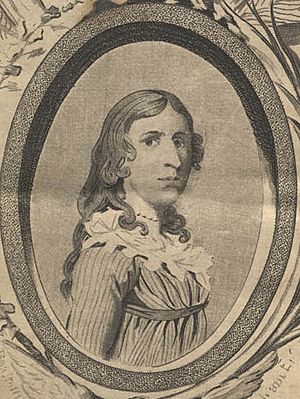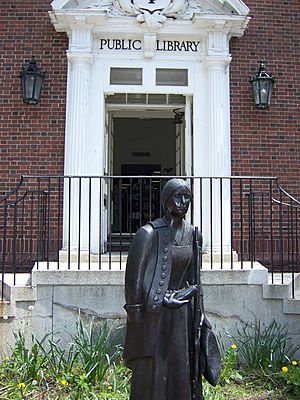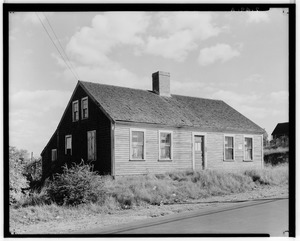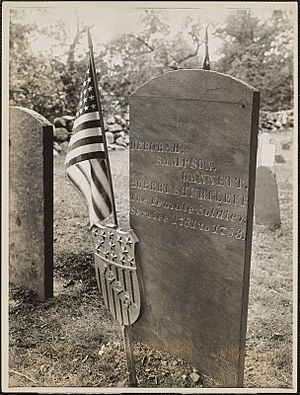Deborah Sampson facts for kids
Quick facts for kids
Deborah Sampson
|
|
|---|---|

Frontispiece of The Female Review: Life of Deborah Sampson, the Female Soldier in the War of Revolution.
|
|
| Born | December 17, 1760 Plympton, Massachusetts |
| Died | April 29, 1827 (aged 66) Sharon, Massachusetts |
| Buried |
Rock Ridge Cemetery, Sharon, Massachusetts
|
| Allegiance | |
| Service/ |
|
| Years of service | 1782–1783 |
| Rank | Private |
| Unit | Light Infantry Company, 4th Massachusetts Regiment |
| Battles/wars | American Revolutionary War |
| Spouse(s) | Benjamin Gannett |
| Relations | 3 children (Earl, Mary, Patience) |
| Other work | Teacher Weaver Soldier Lecturer Farmer |
Deborah Sampson was an amazing woman who bravely dressed as a man to join the American soldiers in the American Revolutionary War. This war was fought between Great Britain and the thirteen original American colonies.
Deborah came from a family that didn't have much money. When she was eight years old, she started working as an indentured servant. This meant she worked for a family without pay until she was eighteen. Even though she worked hard, this family let her study and spend time with their sons, which was unusual for girls back then.
Deborah really wanted to fight in the war against the British. But the American Army only allowed men to join. So, she decided to dress up as a man and successfully joined the Continental Army. She used the name Robert Shurtleff to hide her true identity.
During her time as a soldier, Deborah went to great lengths to keep her secret safe. Once, she was cut on the head by an enemy, and she bandaged it herself. She was also shot in the leg twice. To avoid anyone finding out she was a woman, she pulled the bullets out of her own leg!
Later, she became very sick with a fever and had to go to the hospital. This is where the doctors and her fellow soldiers finally discovered she was a woman. Even though she had lied to join the army, her bravery and service were recognized. Her General and the American Congress honored her for her courage. After the war, she got married, became a teacher, and even gave public speeches about her experiences as a soldier.
Contents
Early life of Deborah Sampson
Deborah Sampson was born on December 17, 1760, in Plympton, Massachusetts. Her family had a long history in America. Her mother was a great-granddaughter of William Bradford, who was the first Governor of Plymouth Colony. Many of her ancestors had even traveled to America on the famous Mayflower ship.
Deborah's family was told that her father died in a shipwreck. But it seems he actually left the family. Her mother couldn't take care of all her children. So, like many families back then, she sent them to live with friends and relatives. Deborah went to live with a relative, and when her mother died, she was sent to live with an older widow named Mary Prince Thatcher.
Historians believe Deborah learned to read while living with Mrs. Thatcher. The widow might have wanted Deborah to read Bible verses to her. This was a great chance for Deborah to learn, as many girls didn't get formal schooling.
After the widow Thatcher passed away, Deborah went to live with the Jeremiah Thomas family in Middleborough, Massachusetts. She worked for them as an indentured servant from 1770 to 1778. Mr. Thomas didn't believe in educating women. But Deborah was determined! She learned from Thomas's sons, who shared their schoolwork with her.
This way of learning worked well. When her time as an indentured servant ended at age 18, Deborah became a teacher. She taught school during the summers of 1779 and 1780. In the winters, she worked as a weaver, making cloth. She was very skilled at weaving.
Deborah also had other talents. She was good at woodworking and fixing things. She could weave baskets and even make small wooden items like milking stools and sleds. She also made pie crimpers, which she sold door to door.
Deborah Sampson's appearance
Deborah Sampson was quite tall for her time. She was about 5 feet 9 inches tall. The average woman back then was around 5 feet tall, and the average man was about 5 feet 6 inches to 5 feet 8 inches. So, her height helped her blend in when she dressed as a man.
Deborah Sampson's army service
In early 1782, Deborah decided to try joining the army. She put on men's clothes and signed up in Middleborough, Massachusetts, using the name Timothy Thayer. She even collected a bonus for joining. However, she didn't show up to meet her company as planned. Someone in town recognized her, and her trick was discovered. She had to pay back the money she received, but she wasn't punished further by the army.
Her church found out about what she did. They were upset and said they wouldn't associate with her unless she apologized.
In May 1782, Deborah tried again. This time, she enlisted in Uxbridge, Massachusetts, using the name "Robert Shirtliff." She joined an elite group called the Light Infantry Company of the 4th Massachusetts Regiment. These soldiers were specially chosen because they were taller and stronger than average. Their job was to move quickly and protect the main army. Because she joined such a strong unit, it was easier for Deborah to hide her identity. No one expected to find a woman among these tough soldiers.
Deborah fought in several small battles. In her first fight, on July 3, 1782, near Tarrytown, New York, she was hit by two musket balls in her thigh. She also got a cut on her forehead. She begged her fellow soldiers not to take her to a doctor, fearing her secret would be revealed. But a soldier put her on his horse and took her to a hospital. A doctor treated her head wound. But before he could look at her leg, she left the hospital.
She bravely removed one of the musket balls herself using a penknife and a sewing needle. But the other one was too deep. She carried that bullet in her leg for the rest of her life, and her leg never fully healed.
In April 1783, Deborah was given new duties. She spent seven months working as a waiter for General John Paterson.
The war was thought to be over after the Battle of Yorktown. But there was no official peace treaty yet, so the army stayed together. In the summer of 1783, Deborah became very ill in Philadelphia. A doctor named Barnabas Binney cared for her. When he removed her clothes to treat her, he discovered she was a woman. The doctor didn't tell the army right away. Instead, he took her to his home, where his wife and daughters helped care for her.
In September 1783, after the Treaty of Paris was signed, soldiers were told they could leave the army on November 3. When Dr. Binney asked Deborah to deliver a note to General Paterson, she guessed it would reveal her secret. Usually, women who pretended to be men in the army were punished. But General Paterson gave Deborah an honorable discharge. He also gave her some advice and money to travel home. She was officially discharged at West Point, New York, on October 25, 1783, after serving for a year and a half.
An official record of Deborah Sampson's service as "Robert Shirtliff" can be found in the "Massachusetts Soldiers and Sailors of the Revolutionary War" book.
Marriage and family
Deborah Sampson married Benjamin Gannett, a farmer from Sharon, Massachusetts, on April 7, 1785. They had three children: Earl, Mary, and Patience. They also adopted a girl named Susanna Baker Shepherd after she became an orphan.
They lived on Benjamin's family farm. However, the farm was small and the land had been used a lot, so it was hard for them to make a good living from it.
Life after the military
In January 1792, Deborah asked the Massachusetts State Legislature for pay that the army had held back because she was a woman. The legislature agreed, and Governor John Hancock signed the order. She was given 34 pounds plus interest, going back to her discharge in 1783.
A book about her life, called The Female Review: Life of Deborah Sampson, the Female Soldier in the War of Revolution, was published in 1797.
In 1802, Deborah started giving public lectures about her time in the war. She would talk about how women should have traditional roles. Then, she would leave the stage, come back in her army uniform, and perform difficult military drills. She did this to earn money and to show why she had joined the army. Even with these speeches, she and her husband struggled to pay all their family's bills. She often had to borrow money from her family and her friend, Paul Revere.
Paul Revere also wrote letters to government officials to help Deborah. He asked that she be given a pension (regular payments) for her military service and her injuries. In 1804, Revere wrote to a U.S. Representative about Deborah. A military pension had never been given to a woman before. But Revere wrote that everyone he talked to spoke of her as a talented woman with good morals, a good wife, and a loving parent. On March 11, 1805, Congress approved her request. Deborah Sampson was placed on the Massachusetts Invalid Pension Roll, receiving four dollars a month.

In 1806, Deborah wrote to Paul Revere again, asking for a loan. She thanked him for his kindness and said her own sickness and her sons' sickness made her need help again. He sent her the money.
In 1809, she asked Congress again to change her pension. She wanted it to start from her discharge date in 1783. If approved, she would have received a lot of back pay. Her request was first denied. But when it came before Congress again in 1816, she was approved for $76.80 a year. With this money, she was able to pay back all her loans and improve her family farm.
Death
Deborah Sampson died on April 29, 1827. She was buried at Rock Ridge Cemetery in Sharon, Massachusetts.
Legacy of Deborah Sampson
Memorials
The town of Sharon remembers Deborah Sampson in several ways. There is a statue of her in front of the public library. There is also a Deborah Sampson Park. Her historic home, the "Deborah Sampson Gannett House," is privately owned. The land around her home is protected so that no new buildings can be built there.
In 1906, the town of Plympton, Massachusetts, placed a boulder with a bronze plaque on the town green to honor Deborah Sampson.
During World War II, a ship called the S.S. Deborah Gannett was named after her.
Since 2000, the town flag of Plympton, Massachusetts includes Deborah Sampson. She is recognized as the Official Heroine of the Commonwealth of Massachusetts.
In books
- Alma Bond and Lucy Freeman, America's First Woman Warrior: The Courage of Deborah Sampson
- Susan Casey, “Women Heroes of the Revolution"
- Samuel Willard Crompton, “Deborah Sampson"
- Ann McGovern and Katherine Thompson, The Secret Soldier: The Story Of Deborah Sampson
See also
 In Spanish: Deborah Sampson para niños
In Spanish: Deborah Sampson para niños




